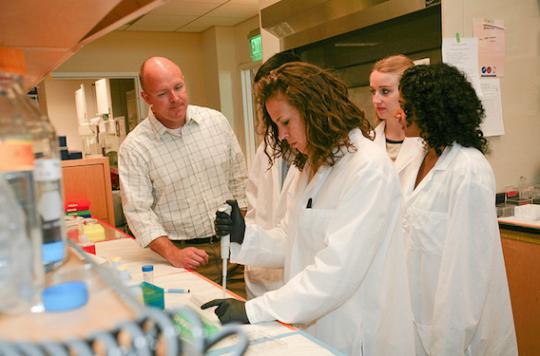Research on gene therapy is advancing. In diseases of the central nervous system, several approaches are being tested. A vector virus is the key: the adenovirus.

Viruses can cure illnesses. Voluntarily injected into the body, some are capable of harboring genes modified in the laboratory and then becoming drugs. Gene therapy is particularly valuable in the fight against pathologies that find their source in DNA. Recently, real progress has been made in this sector, explains a French team in Human Gene Therapy. Whether genetic or acquired, a large number of neurological conditions could soon benefit. Among them: Alzheimer’s, Parkinson’s and several rare diseases.
Correct a faulty gene
Gene therapy, “it is no longer science fiction, summarizes Nathalie Cartier, co-author of this review contacted by Why actor. Several trials have been carried out and more than 300 patients worldwide have benefited from them. “In fact, some 1,800 clinical trials are underway to date, according to Inserm. The vast majority are in oncology (65%). A tumor suppressor drug has even been available in China since 2004 for the treatment of head and neck carcinomas.
Barely 1 in 10 trials are interested in the treatment of so-called monogenic diseases (caused by a single gene), such as Huntington’s. About fifty rare pathologies of the central nervous system correspond to this definition. Although infrequent, they are a priority target because they are serious and most have no treatment. “They represent important models for these innovative approaches,” explains Nathalie Cartier. Indeed, only one gene is deficient, causing the lack of an associated protein. “The idea is therefore to provide this protein using a gene therapy vector”, develops the Inserm researcher.
From rare diseases to the most frequent
The leads are becoming more and more clear, however. Preclinical data from work on animal models is accumulating. Phase I or II trials are now being carried out in humans, in childhood leukodystrophy and lysosomal diseases for example. “The determination of Karen Aiach, president of Lysogene, made it possible to deliver a therapeutic trial with encouraging results in type 3 mucopolysaccharidosis”, illustrates Nathalie Cartier. Another trial, underway at the Kremlin-Bicêtre hospital and co-directed by Nathalie Cartier, attempts to treat children with severe forms of metachromatic leukodystrophy.
Most often, these trials combine phase I and II, intended to show that the approach is not toxic and to prove its effectiveness. Another way to save time in a sector where it is lacking. Because without treatment, life expectancy can be very short. “Much progress has been made, even if the trials involve small numbers of patients,” said Nathalie Cartier nonetheless.
The progress is such that specialists are now interested in more complex neurological pathologies, such as Parkinson’s or Alzheimer’s. They are also more frequent. The impact can therefore be major. Because if lysosomal storage syndromes affect one in 7,000 births, Alzheimer’s affects 850,000 people in France alone.

Interfere with disease mechanism
The strategy adopted in Parkinson’s disease no longer consists in correcting the activity of a gene but in increasing the secretion of dopamine using a lentivirus. Symptoms of this neurodegenerative disease are caused by too low a concentration of this neurotransmitter in the brain. “The results of Stéphane Palfi’s group at Henri-Mondor hospital (Créteil) are encouraging. We now have to refine the technology, ”says Nathalie Cartier.
The road to Alzheimer’s gene therapy is more chaotic. “The idea is to stop neuronal death and the accumulation of amyloid in the brain,” develops the researcher biologist. The strategy is based on correcting the metabolic disorders of cholesterol in the brain, which we have identified in Alzheimer’s and Huntington’s diseases. These trials are still in the pre-clinical phase. In particular, they will have to show that the accumulation of proteins in the body is not harmful (see box).
But Nathalie Cartier hopes to achieve a first experiment in humans by 2019. She will first test the approach on Huntington’s disease, where treatment is more urgently needed. This genetic disease, which affects young adults, has no treatment. However, life expectancy is only 15 to 20 years after the onset of symptoms.

A virus that is not very toxic to the body
Gene therapy directed against diseases of the central nervous system is based on viruses, including a family of common viruses: adeno-associated viruses (AAV). “AAV is a very good vector, well tolerated and it is not toxic”, underlines Nathalie Cartier. Toxicity is precisely at the heart of pre-clinical trials. The stakes, it must be said, are considerable. The adenovirus makes it possible to dispel doubts about the first of the three critical aspects. This is because the immune system must not react against the vector, otherwise the therapy may not be active. “The brain is a relatively protected tissue, and it provokes little response against the virus, when it is administered locally”, specifies the biologist from Inserm. Neurosurgery is precisely the preferred route of administration.
But the goal, in the longer term, is to achieve less invasive methods, by the development of viral vectors that can be injected into the cerebrospinal fluid (by a method similar to the lumbar puncture) or into the blood system. They will then be able to cross the blood-brain barrier, which protects brain tissue. But the doses needed will be higher, and the risk of an immune response will be higher.
The last crucial aspect of gene therapy is at its heart: the expression of the therapeutic protein must not lead to undesirable effects. In rare diseases, the approach is generally well tolerated. “In more common diseases, the increased expression of a gene already expressed must not be toxic to the cells,” explains Nathalie Cartier. The purpose of the work on the animal is to make sure of this.
.















